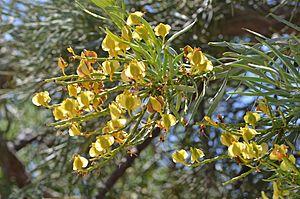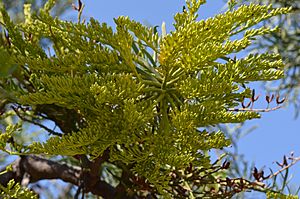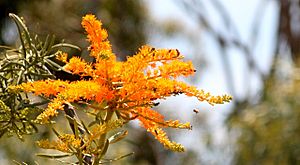Nuytsia facts for kids
Quick facts for kids Nuytsia |
|
|---|---|
 |
|
| Scientific classification | |
| Genus: |
Nuytsia
|
| Species: |
floribunda
|
| Synonyms | |
|
|
The Nuytsia floribunda is a special tree found only in Western Australia. People often call it moodjar or the Western Australian Christmas tree. This is because its bright, beautiful flowers bloom during the summer, right around the Christmas season! It's a very unique tree because it's a hemiparasite, which means it gets some of its food and water by connecting to other plants.
Contents
What Does the Nuytsia Tree Look Like?
This amazing tree can grow up to 10 metres (33 ft) (about 33 feet) tall, or it can be a smaller shrub. Its bark is rough and grey-brown. The flowers are a super bright yellow-orange color. You can see them from October to January. Each flowering stem can grow up to one meter (about 3 feet) long, covered in these vibrant blooms!
How Does the Nuytsia Get Its Food?
The Nuytsia is a hemiparasite. This means it can make its own food using sunlight, just like most plants. But it also gets extra water and important minerals from other plants. It does this using special parts of its roots called haustoria. These haustoria attach to the roots of many nearby plants. They can even attach to underground cables! The Nuytsia doesn't take too much from any one plant. But since it connects to so many, it gets a lot of help.
The roots of the Nuytsia can spread out far underground. They can even grow new trees, making it look like a group of trees is growing together. From these big underground roots, tiny, delicate roots grow. These are the ones that form haustoria when they meet other plant roots.
The main trunk of the tree can be very wide, up to 1.2 meters (about 4 feet) across. It has many layers of wood and bark. This helps the tree survive bushfires. Another cool thing about young Nuytsia plants is that they have four to six cotyledons (seed leaves) when they sprout, instead of the usual two.
The Nuytsia's Name and History
Scientists first thought the Nuytsia belonged to a group of plants called mistletoes. But now, it's known as its very own unique type of tree, called a monotypic genus. This means it's the only species in its group, Nuytsia.
How the Nuytsia Got Its Scientific Name
The first scientist to describe this tree was Jacques Labillardière in 1805. He called it Loranthus floribundus. The word floribundus means "flowering profusely," which perfectly describes its many flowers. Later, another botanist named Robert Brown gave it the name Nuytsia. This name honors a Dutch explorer and official from the 1600s, Pieter Nuyts.
Other Names for the Nuytsia Tree
The Noongar people, who are the traditional owners of the land where this tree grows, have several names for it. These include moojar, moojerool, munjah, and mutyal.
The name 'Christmas tree' has been used since the 1800s. In 1843, a botanist named James Drummond said that people in the Swan River area called it the 'fire-tree'. This was because its bright flowers looked like a fire in the bush. Another early settler called it the 'cabbage tree'. This was because its branches were soft and white, and could be snapped off easily, like a cabbage stalk.
Where Does the Nuytsia Tree Grow?
The Nuytsia floribunda is very well known in Southwest Australia. Its huge display of flowers in summer is truly amazing! Even though its seeds grow easily at first, it's very hard to grow a Nuytsia tree to full size outside of its natural home. It can grow in many different types of soil. You can find it from the Esperance Plains in the east to the Geraldton Sandplains in the north. You can see where it grows on maps like The Australian Virtual Herbarium.
This tree used to be very common around Perth, on the Swan Coastal Plain. But much of that land has now been cleared for buildings and farms.
Uses of the Nuytsia Tree
The Noongar people have used the Nuytsia tree for a long time. During the Kambarang season (around October to early December), they would use its bark to make shields. The tree also produces a sweet, sticky gum. This gum can be collected and eaten raw.
The moodjar tree is very important to the Nyungar people of Southwest Australia. They consider it a protected tree. It's part of their traditions and rituals, and they believe it should not be destroyed. Some people even believe you shouldn't sit under it or touch its flowers, leaves, or branches. The sweet gum is eaten in small amounts. Children are sometimes told a story about a scary creature that collects the gum if they eat too much! Other groups also used the roots of the tree. One person described the roots as sweet, crunchy, and watery after the skin was removed.
Other Interesting Facts About the Nuytsia
In 1921, a forest conservator named Charles Lane Poole said the wood of the Nuytsia wasn't good for commercial use. He thought its only good quality was its beautiful flowers. He also mentioned that the gum from the tree might be useful.
The artist Marianne North painted the tree around 1880. Her painting is called 'Study of the West Australian Flame-tree or Fire-tree' and is now at Royal Botanic Gardens, Kew. She wrote about how amazing it was to see a plain "entirely surrounded by the nuytsia or mistletoe trees, in a full blaze of bloom. It looked like a bush-fire without smoke." An early settler, George Fletcher Moore, called this parasitic tree another "anomaly in this land of contradictions."
A scientific journal about plants, called Nuytsia, is named after this tree. It is published by the Western Australian Herbarium.
Nuytsia and Its Environment
The bright flowers of the Nuytsia make a lot of pollen and nectar. This is a tasty treat for insects like bees!
For a long time, people didn't fully understand how the Nuytsia was a parasite. They thought it needed to be very close to other specific trees like banksia or eucalyptus. But a botanist named D. A. Herbert discovered that the Nuytsia has a huge network of tiny roots. These roots can connect to almost any other plant's roots! This explained why Nuytsia trees could still grow in farm fields, even after most other plants were cleared.
Scientists have found that the Nuytsia can parasitize a huge variety of plants, both native and introduced. There's only one known plant species that seems to be safe from its attack. This means the Nuytsia can attach to almost anything within its reach!
The Nuytsia floribunda used to be very common around Perth. You could often see it in leftover bushland and gardens. But as more cities and towns grew, it became much rarer.
See also
 In Spanish: Nuytsia floribunda para niños
In Spanish: Nuytsia floribunda para niños





